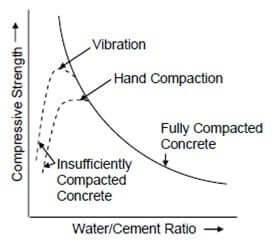Workability is a property of raw or fresh concrete mixture. In simple words, workability means the ease of placement and workable concrete means the concrete which can be placed and can be compacted easily without any segregation.
Workability is a vital property of concrete and related with compaction as well as strength. The desired workability is not same for all types of concrete. More workability is required for a thin inaccessible section or heavily reinforced section rather than a mass concrete body. Hence, we can’t set a standard workability for all casting works.
Compaction and workability are very close to each other. Workability can also be defined as the amount of useful internal work necessary to produce full compaction.
Workability is the property determining the effort required to manipulate a freshly mixed quantity of concrete with minimum loss of homogeneity
Workability is that property of freshly mixed concrete or mortar which determines the ease and homogeneity with which it can be mixed, placed, consolidated and finished
Reason for Different types of definition
A variety is seen between definitions of workability because it is not very accurate scientific term like specific gravity or weight. All definitions are qualitative in nature and personal viewpoint is reflected instead of scientific precision. There are some other terms used to describe concrete as cohesiveness, consistency, flowability, mobility, pump-ability etc. These terms have their specific meaning but they cannot be determined inaccurate number or unit.
Types of Workability of Concrete
Workability of concrete can be classified into following three types:
- Unworkable Concrete: An unworkable concrete also known as harsh concrete, is a concrete with a very little amount of water. The hand mixing of such concrete is difficult. Such type of concrete has high segregation of aggregates. and it is very difficult to maintain the homogeneity of concrete mix.
- Medium Workable concrete: Medium workable concrete is used in most of the construction works. This concrete is relatively easy to mix, transport, place, and compact without much segregation and loss of homogeneity.
- Highly Workable Concrete: This type of concrete is very easy to mix, transport, place and compact. It is used where effective compaction of concrete is not possible. The problem is that there are high chances of segregation and loss of homogeneity in highly workable concrete.
{adselite}
Desirable Workability for Construction
Desirable workability depends on two factors which are:
- Section size, amount and spacing of reinforcement: When a section is narrow, complicated, several narrow corners, inaccessible parts; a highly workable concrete is desirable to obtain full compaction through a reasonable amount of effort. When the section is crowded with steel reinforcement and spacing of bars is relatively small, compaction can be difficult and hence highly workable concrete is recommended in such cases. If there are no limitations of the critical section or heavy reinforcement, we can get a wide range of workability for concrete casting.
- Method of compaction: If concrete is compacted manually, more workability is recommended because hand compaction is not very much uniform and effective. If there is a scope of the vibrator or machine compaction, we can choose workability from a wide range.
Strength of Concrete & Workability Relationship
The strength of concrete is the most important property for us. It depends on density ratio or compaction and compaction depend on sufficient workability. Fresh concrete must have a workability as compaction to maximum density is possible with a reasonable amount of work.

But excessive workability can lessen compressive strength. From the above graph, we see that compressive strength of concrete decreases with increase in w/c ratio. An increase of w/c ratio indicates an increase of workability. Hence, the strength of concrete inversely proportional to the workability and too much workability should be avoided.
Methods of Improving Workability of Concrete
To increase workability there are some ways like:
- Increasing water/cement ratio
- Using larger aggregate
- Using well-rounded and smooth aggregate instead of irregular shape
- Increasing the mixing time and mixing temperature
- Using non-porous and saturated aggregate
- With addition of air-entraining mixtures
- Adding appropriate admixtures

